Sourdough Sandwich Bread with a Soft Crust
Sourdough Sandwich Bread is made with milk, butter & active sourdough starter. This soft crust sourdough bread has a tender crumb and awesome flavor. It makes a perfect sandwich.
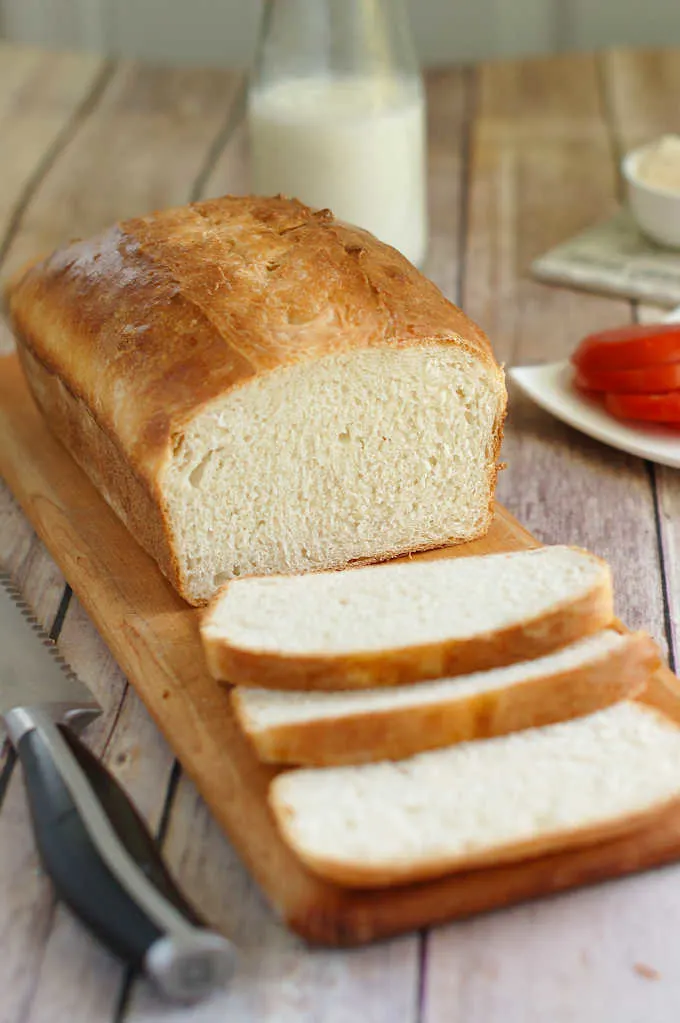
Table of contents
Why this is the best Sourdough Sandwich Bread
White Sandwich Bread doesn’t have to have the lackluster taste and squishy texture of a certain “wonderous” bread that many of us ate growing up. This sourdough sandwich bread has deep flavor, a beautiful texture and a soft crust.
Milk, butter and a whisper of sugar create a perfectly soft white bread that is ideal for making a great PB&J or BLT.
Although this recipe takes a good 8-12 hours from start to finish, the vast majority of the time is hands off.
To make this recipe even more convenient, you can let the dough rise over night. A long rise in the refrigerator does only good things for the bread.
If you don’t already have one, I can show you how to make a sourdough starter and how to feed a sourdough starter.
Ingredients

Ingredient Notes
- Sourdough Starter – This recipe was developed using 100% hydration starter. You will need to adjust the liquid or flour in the recipe if you’re starter isn’t at 100% hydration.
- All Purpose Flour – Medium protein AP flour makes a bread with a soft crumb yet develops enough gluten so the bread rises high in the oven.
- Milk – Scalding denatures (breaks down) proteins in the milk which can interfere with gluten development.
- Butter – A little fat softens the crumb of the bread.
- Salt – For flavor.
- Sugar – Enhances browning and make the crumb soft and slightly sweet.
How to make Sourdough Sandwich Bread with a soft crust
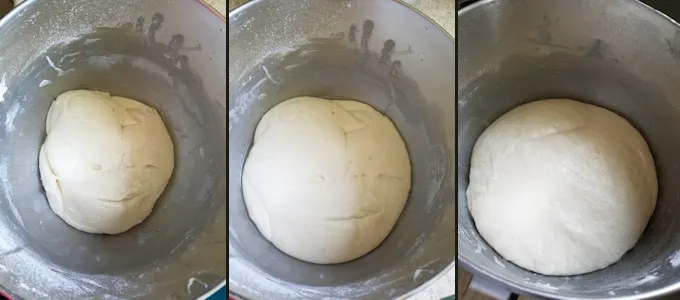
- Mix the dough and set it aside for the initial fermentation.
- With each hour of fermentation the dough will rise higher, become more active and more elastic.
- After the initial fermentation you can continue on to shape and bake the loaf, or you can refrigerate the dough overnight and continue the next day. A long, cool rest in the refrigerator enhances the flavor and texture of the dough.
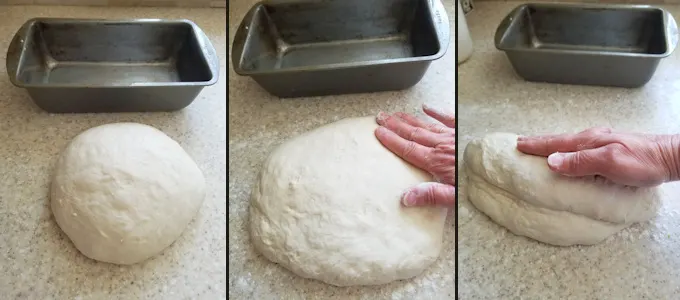
- Turn the dough out onto a lightly floured surface.
- Without kneading out the air, gently form the dough into a rectangle.
- Roll the rectangle into a log and set into a lightly greased loaf pan.
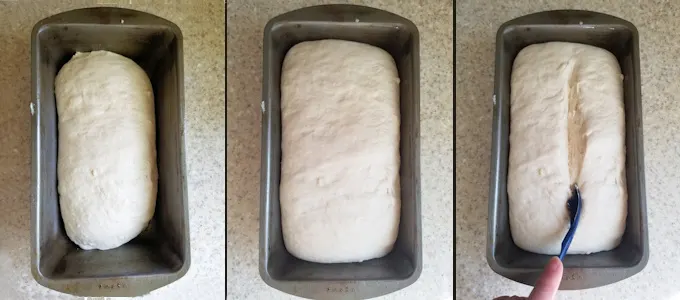
- Cover the pan and set the loaf aside to rise.
- The dough will expand to almost fill the pan.
- Slash the top of the loaf to promote even rising in the oven.
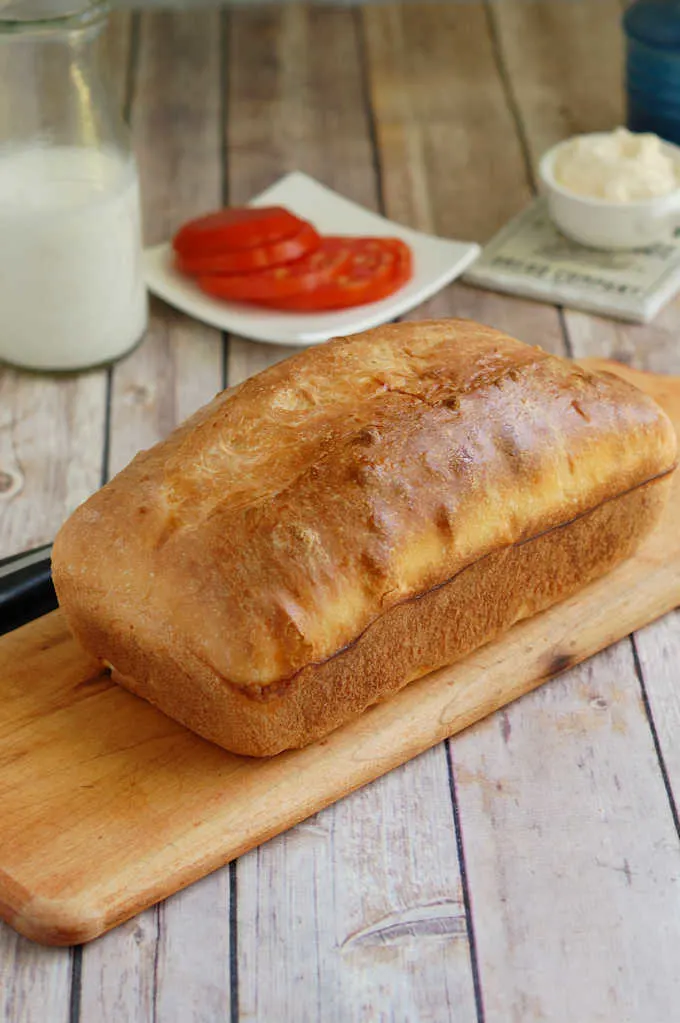
- Brush the loaf with egg wash and bake until the interior temperature is 200F.
- Cool the loaf completely before cutting.
A timeline for making Sourdough Sandwich Bread:
- If your starter needs feeding, do that the night before or early in the morning of the day you want to make the dough.
- Mix the dough in the afternoon, allow it to ferment for 3-4 hours then refrigerate the dough before going to bed.
- Take the dough out of the refrigerator first thing in the morning, shape the loaf and set it into the pan.
- To warm up the dough, turn on the oven just until it’s barely warm. Turn off the oven and set the pan with the cool dough in the oven. Remove the pan once the dough is back to room temperature. You can skip this step, but it does speed up the rising time.
- Leave the loaf to rise for 1 1/2- 2 hours, or as long as is needed to almost double in size.
- To make and bake the dough in the same day, feed your starter the evening before so it’s active by morning. Start the dough early in the morning and it should be ready to bake by late afternoon or early evening.
Storage
Sourdough Sandwich bread will keep at room temperature for 2-3 days. The bread (sliced or whole) can be frozen for up to a month.

I know you hate to throw away that sourdough discard. Check out these recipes that use sourdough discard.
More great sourdough breads
- Whole Wheat Sourdough Bread
- Sourdough Hoagie Rolls
- Sourdough Multigrain Bread
- Sourdough Semolina Bread
- Sourdough Rye Bread
- Crusty Sourdough Bread
If you love this recipe as much as I do, I’d really appreciate a star rating and a quick comment. Ratings and comments help my recipes show in search results. Thanks!
Sourdough Sandwich Bread Recipe
Ingredients
- 8 oz whole milk (1 cup)
- 1 oz unsalted butter
- 8 oz active sourdough starter (1 cup, 100% hydration)
- ½ oz granulated sugar (1 tablespoon)
- 1 ½ teaspoons salt
- 12 ½ oz all purpose flour (2 ½ cups, see note)
- 1 large egg (for egg wash)
Instructions
- Warm 8 oz whole milk in the microwave to until scalding hot (just before it comes to a boil.) Stir 1 oz unsalted butter into the warm milk to melt. Set the milk aside to cool until it's slightly warmer than body temp.
- In a mixer bowl, combine the warm milk with 8 oz active sourdough starter, ½ oz granulated sugar and 1 ½ teaspoons salt and stir to combine. Add 1 ½ cups of the flour and stir until the batter looks like thick pancake batter. If using a stand mixer, change to the dough hook.
- With the mixer running, slowly add the remaining flour until the dough gathers on the hook and clears the sides of the bowl. Knead for 5 minutes. If mixing by hand, stir in as much flour as you can then turn the dough out onto a floured surface and knead in the remaining flour.
- Remove the dough from the bowl onto a lightly floured surface. The dough should be soft and slightly sticky. Knead to form a smooth ball. If the dough is very sticky sprinkle a little more flour as you knead.
- Place the dough in an oiled bowl, turning once to coat the dough. Cover the bowl and set it aside at room temperature.
- After 60 minutes uncover the bowl, lift one side of the dough and fold it into the middle of the dough. Repeat with the other three sides of the dough then flip the dough over. You're basically turning the dough inside-out to redistribute the yeast and strengthen the gluten. Cover the bowl and after 60 minutes repeat the procedure.
- Cover the bowl and after 60 minutes fold the dough one more time. By now the dough should be lively, elastic and airy. If the dough is still sluggish give it another hour or two at room temperature. If you want to finish making the bread in the morning return the dough to the bowl, cover tightly and refrigerate overnight. The next morning continue with shaping. Otherwise continue shaping the loaf on the same day.
- Grease a 9"x 5" loaf pan with a very light film of vegetable oil.
- Turn the dough out onto a floured surface and without kneading out the air, gently push the dough to a 9" rectangle. Tightly roll the dough to form a log.
- Set the dough into the pan and cover with a damp kitchen towel or oiled plastic wrap. Set in a warm place and rise until the dough is doubled in size, about 1-1½hours.
- Preheat the oven to 350 °F. Use a sharp knife or razor to cut a 1/2" deep slash down the center of the loaf. Brush the loaf with egg wash.
- Bake about 30-35 minutes until golden brown and and a toothpick inserted in the center comes out clean. The interior temp should be 200 °F.
- Cool in the pan for 5 minutes before turning out onto a cooling rack. Finish cooling to room temperature before slicing,
Would you like to save this recipe?
As an Amazon Associate and member of other affiliate programs, I earn from qualifying purchases.








Thank you for this recipe! I started a little late in the day and finished around 11 pm. Worth it! Now I have to obsess over all your recipes!
Thanks!
Wow! this was great. I’m making another loaf today. When Corona hit I like many others started to experiment with bread in the kitchen. This has been a recipe that got me to my first truly successful sandwich loaf. I still have a lot to learn, but it sure has been fun!
Do you stir down your starter before measuring it out? And do you prefer weight or volume measurements for this recipe? Thanks!
I always prefer weight measures as they are more accurate. You’ve hit on the problem with volume measures exactly. I don’t stir the starter down before measuring. I’ve done it a bunch of times and as long as the starter is pretty active, a cup is very close to 8 oz. But, again, if you have a scale do weight measures.
I missed the step about rolling it tightly into a log before placing in pan. Will this have an impact in how it turns out?
No, It should be fine. The shape might be a bit different, but the pan will help it rise to the right shape.
Sorry if this has already been asked. I looked through the comments but there are SO MANY of them. Haha. I made this yesterday and it turned out great. I did make the dough the night before and then refrigerate overnight. I was wondering if refrigeration is necessary. When I make my regular sourdough I leave it to ferment at room temp for a very long time, almost 24 hours, for that added health benefit. I noticed it took a long time for the dough to come back to room temp, and I was wondering if it would be bad to just leave this out all night. Does the milk make it prone to spoil? Curious if you’ve ever done this. Thanks!
Hi Tarrah. I wouldn’t worry so much about leaving the dough out because of the milk. It will be baked in the end. The long, cool rise in the refrigerator does do nice things for the texture and flavor of the bread. At cooler temp the dough will develop a little more of the acetic tang. The cooler temp also slows down the yeast activity. I would worry that the dough would tire itself out and the yeast might be less active being left at room temp that long. Have you not had this problem with your regular bread?
Hmm. I don’t know. Lol. Maybe it would be better if I did refrigerate my regular dough. I don’t really understand the science of all of this. I’m still learning. When I leave it overnight, it is huge in the morning, but I just deflate it, stretch and fold and leave it a couple more hours before shaping and then letting it proof again before baking.
As long as you have no trouble with the final proof you’re yeast is still happy. When you leave it out overnight, how long has it been fermenting at that point? If you mix the dough late in the evening and then leave it overnight you’re doing most of the fermentation time during the night. If you mix the dough and leave it ferment for several hours (as my recipe does) and then leave it overnight that’s a much longer fermentation at room temp. Do you see what I’m saying?
When I made your recipe, I started late at night, so it didn’t have very long before I put it in the fridge. I left it out for several hours before baking the next day. With my usual bread, the fermentation time varies quite a bit, but it’s usually anywhere from 18-24 hours. I know some people ferment a VERY long time so that it is almost considered “gluten free” in terms of how it reacts with your gut. My mom doesn’t eat gluten, but she can eat sourdough that has had a long ferment. So when you put it in the fridge, does that disrupt the fermentation process? I’ll have to try it both ways to see how it affects the loaf. I definitely haven’t had any trouble getting it to continue rising and proofing after a long ferment. I was thinking it would be easier to just bake first thing in the morning if I left it out overnight rather than having to let come back to room temp.
I’m not an expert so I can’t comment on the gut reaction/longer fermentation. But putting the dough in the fridge doesn’t stop the fermentation, it just slows it down. The cool temp promotes more acetic acid which gives the bread a slightly tangier flavor. If you want to do a very long fermentation you can just leave it in the refrigerator longer than over night. I’ve left dough for a full day before shaping and baking. But you could definitely mix the bread late in the evening and leave it out to ferment overnight. I’ve done that myself with my sourdough bagel recipe with good results.